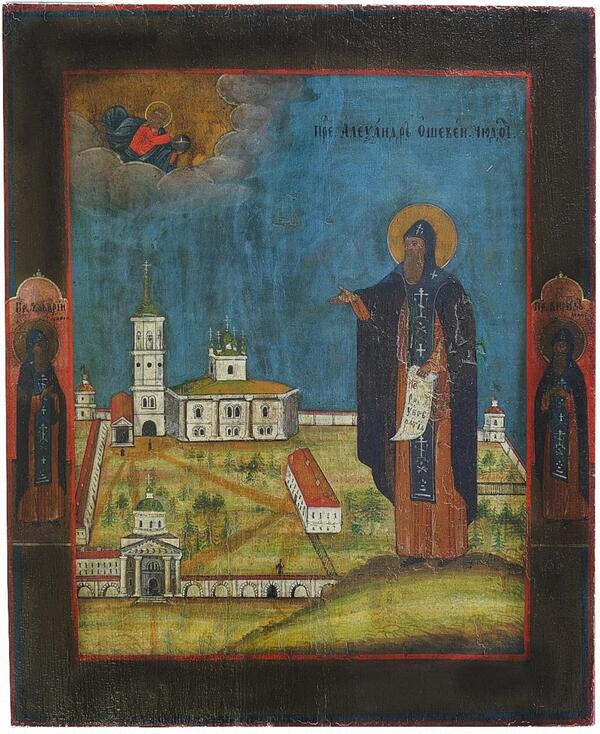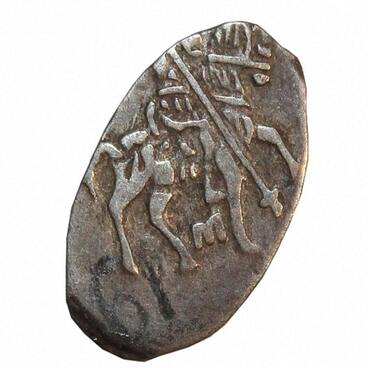Icons with Saint Alexander Oshevensky appeared in the 15th century, almost 100 years after his death. The earliest extant monuments with this saint date back to the end of the 16th century. The work from the museum’s collection dates back to the 18th century.
In the Russian North, images of the Saint were very common, especially in the Kargopol and Onega regions. Here they were in almost every temple. The importance of the saint for these places was also emphasized by the frequent inscription in Russian “Kargopol Wonderworker” on his icons. The popularity among the local and especially rural population was largely explained by the people’s memory of his peasant origin. The saint spent a lot of time educating local farmers.
On the icon from the museum’s collection, Saint Alexander is depicted on the right. He is depicted in full height in monastic attire. In his left hand, he holds an unfolded scroll with an inscription. To the left of it, there is a monastery: the Assumption Cathedral with a bell tower, the Gate St. Nicholas Church, the fraternal building and a room for pilgrims are surrounded by a fence. At the top of the icon, the artist left an inscription: “ST. ALEXANDER OSHEVENSKY THE WONDERWORKER”. In the margins, he depicted two saints in an ornamented frame —Macarius of Unzha on the left and Cyril of Chelma Hill on the right.
In the 17th century, a special genre appeared in Russian icon painting depicting saints together with the monasteries they founded. Despite the simplified nature of the imagery, such icons faithfully convey the features of monastic architectural ensembles. They often serve as a reliable source for the reconstruction of the appearance of buildings: in the old days, monasteries were often rebuilt, and icon painters recorded those changes.
Icons where Alexander Oshevensky was depicted next to the monastery he had founded have become one of the most common images of the Saint. At first, the Oshevensky monastery was made entirely of wood, with two tent temples and a bell tower. It was surrounded by log walls. Then the buildings gradually changed to stone ones — a new five-domed Assumption Cathedral appeared, the Gate St. Nicholas Church, as well as walls and outbuildings. The icon shows the final version of the monastery, built in stone.
In the Russian North, images of the Saint were very common, especially in the Kargopol and Onega regions. Here they were in almost every temple. The importance of the saint for these places was also emphasized by the frequent inscription in Russian “Kargopol Wonderworker” on his icons. The popularity among the local and especially rural population was largely explained by the people’s memory of his peasant origin. The saint spent a lot of time educating local farmers.
On the icon from the museum’s collection, Saint Alexander is depicted on the right. He is depicted in full height in monastic attire. In his left hand, he holds an unfolded scroll with an inscription. To the left of it, there is a monastery: the Assumption Cathedral with a bell tower, the Gate St. Nicholas Church, the fraternal building and a room for pilgrims are surrounded by a fence. At the top of the icon, the artist left an inscription: “ST. ALEXANDER OSHEVENSKY THE WONDERWORKER”. In the margins, he depicted two saints in an ornamented frame —Macarius of Unzha on the left and Cyril of Chelma Hill on the right.
In the 17th century, a special genre appeared in Russian icon painting depicting saints together with the monasteries they founded. Despite the simplified nature of the imagery, such icons faithfully convey the features of monastic architectural ensembles. They often serve as a reliable source for the reconstruction of the appearance of buildings: in the old days, monasteries were often rebuilt, and icon painters recorded those changes.
Icons where Alexander Oshevensky was depicted next to the monastery he had founded have become one of the most common images of the Saint. At first, the Oshevensky monastery was made entirely of wood, with two tent temples and a bell tower. It was surrounded by log walls. Then the buildings gradually changed to stone ones — a new five-domed Assumption Cathedral appeared, the Gate St. Nicholas Church, as well as walls and outbuildings. The icon shows the final version of the monastery, built in stone.



